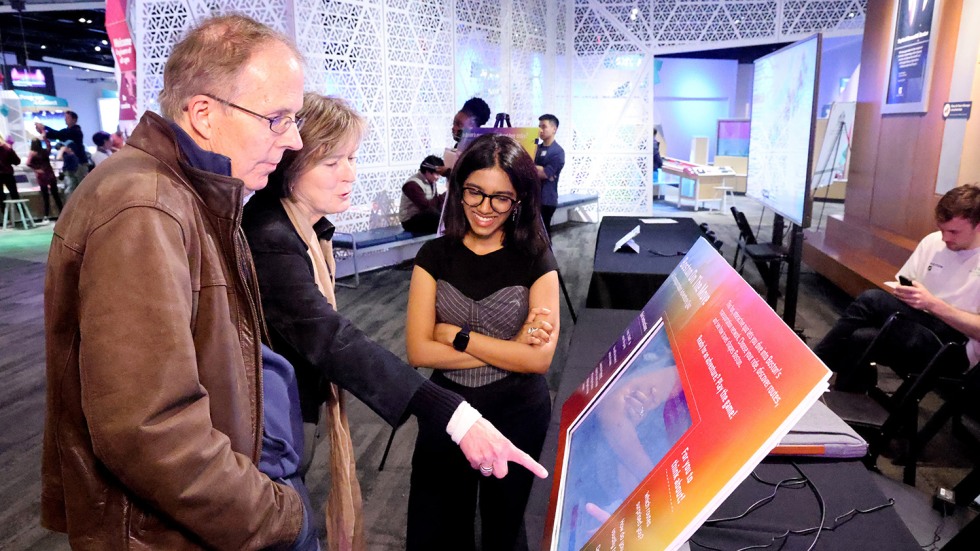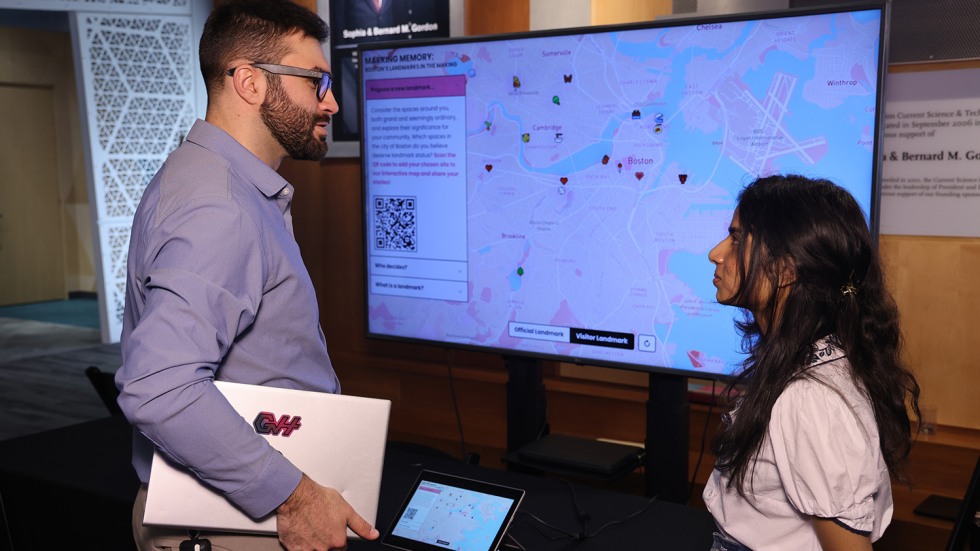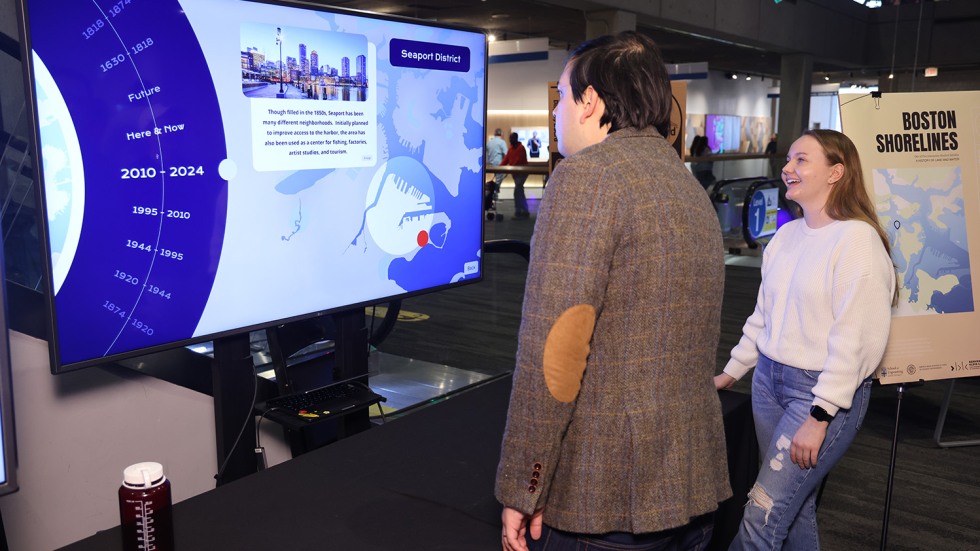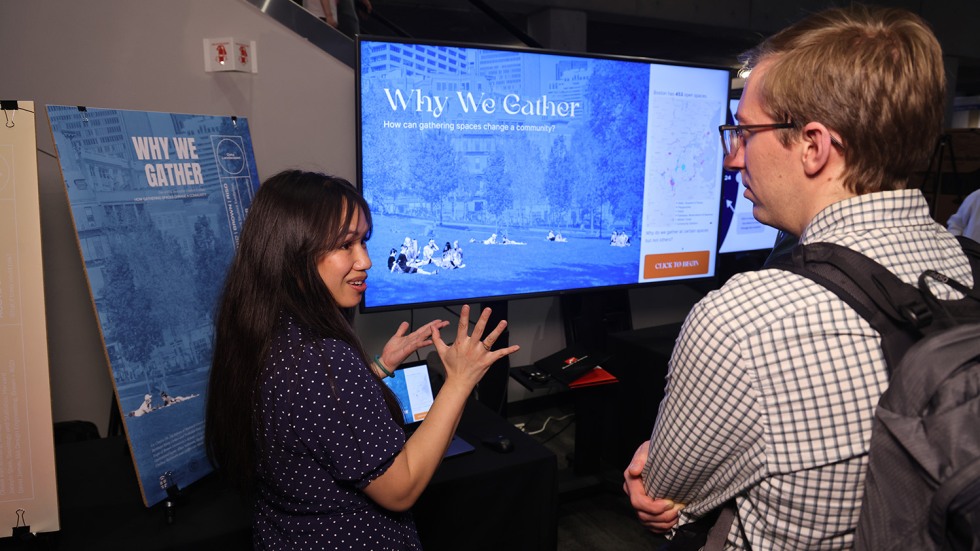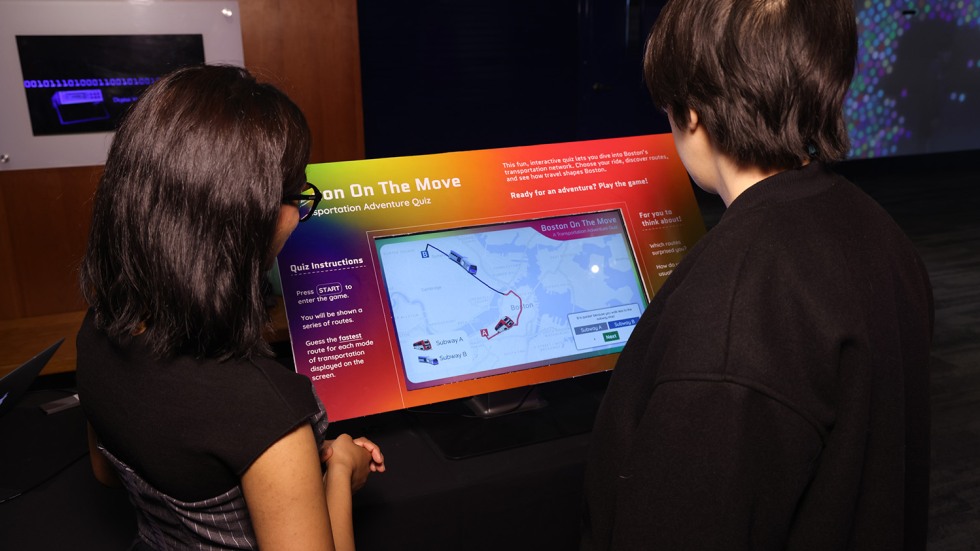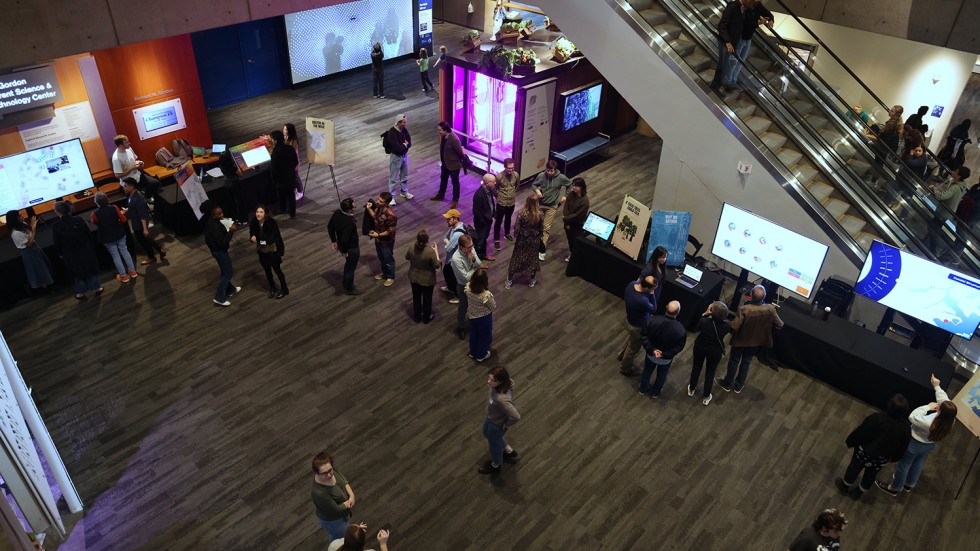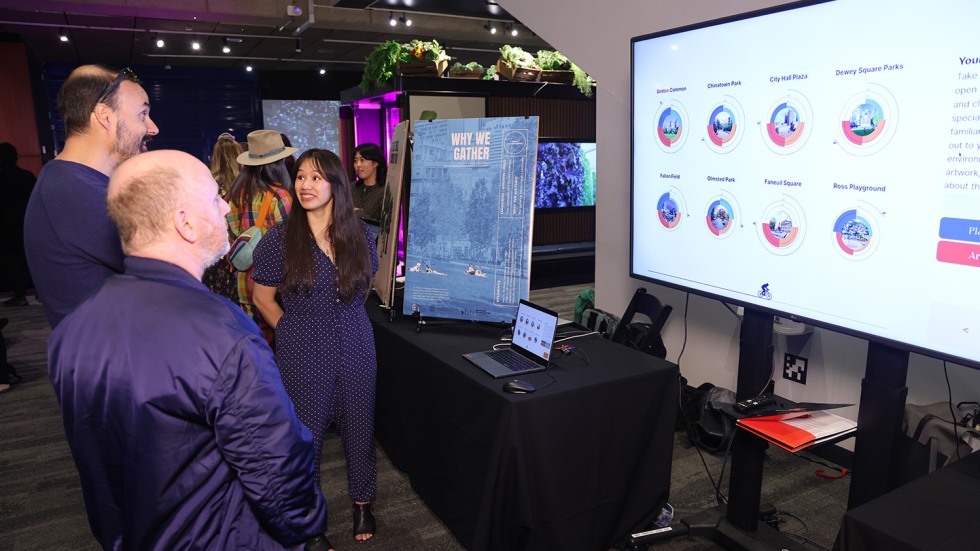The Master of Arts in Design Engineering (MADE) program at the Brown University School of Engineering and RISD, in partnership with the Berkman Klein Center for Internet & Society at Harvard University and the Edgelands Institute, showcased “Boston’s Data Landscapes: Visualizing the Urban Experience” at the Museum of Science, Boston on Wednesday, April 17, 2024.
Over eight weeks, a diverse cohort of students from the MADE program at Brown and RISD and Harvard University immersed themselves in the wealth of data available through Boston’s public data hub, Analyze Boston. Their mission: to uncover novel, meaningful, and joyful perspectives on navigating and understanding the urban environment with an extraordinary collection of interactive data visualizations of the Bostonian experience. From envisioning the evolving contours of Boston’s coastline to revealing the secret lives of the city’s trees, each of the students’ visualizations beckoned to embark on an intellectual and sensory exploration of urban life. Visitors to the Museum of Science explored how local vibrancy generates data – from the movements of neighbors to the ecological changes shaping the landscape.
MADE’s Exhibits on Display
MADE’s Krithika Balaraman, David James, Esther Krupp, Katie Lynch, Samyuktha Sam, Sunny Satpathy, and Amy Vu each collaborated in groups of students from their own cohort and Harvard to present five different exhibits that were presented in the Blue Wing of the museum during Massachusetts and Rhode Island’s public school vacation week.
Balaraman’s Marking Memory; Boston’s Landmarks in the Making is a visualization of all the landmarks in Boston that have been approved, denied, or are pending approval from the landmarks commission. Patterns of which sections of Boston have had more landmarks approved tells an interesting story. The project also featured an interactive map, where visitors could add in personal landmarks of importance to them.
James and Satpathy’s Roots of Boston, is an interactive invitation to visitors to explore the history of Boston through the perspectives of trees both old and new. The project is designed to instill a renewed appreciation for trees by posing a simple yet profound question: “What have these trees witnessed?”
Krupp and Lynch’s Boston Shorelines: A History of Land & Water was a series of interactive maps of the history of Boston shorelines, starting in 1630. Major projects that shaped the city during different time periods, including the “Big Dig” & “The Back Bay Basin,” were highlighted.
Sam’s project, Boston on the Move, featured an interactive quiz designed to evaluate public perception of Boston’s transportation network in relation to access to essential services. By exploring different transportation options and their connections to key public service locations, the project emphasized the impact of urban mobility on enabling or obstructing civic participation in Boston.
Vu’s Why We Gather explored how Boston’s open spaces impact community. Using open data, the interactive story examined how play, environment, food, and art influence gathering, inspiring visitors to rediscover local spaces with a new perspective.
“We hope this exhibit inspires people to reimagine their connection to the city and the rich tapestry of data that underpins it,” said Lis Sylvan, Senior Director of Strategy and Programming at the Berkman Klein Center. “Many luminaries, both local partners and international experts, generously shared their insights with the students in this Research Sprint. The students took it all in and applied what they learned to their data visualizations. Together, we demonstrated the transformative potential of inter-institutional collaboration in addressing contemporary challenges."
Attendees journeyed through the city's past, present, and future, exploring how a landmark becomes a landmark, what public spaces tell us about why we gather in them, and how the layout of the city’s public transit network could impact democratic processes.
The Museum is in the midst of its “Year of Our Earthshot,” a yearlong exploration of the climate solutions that will help us all live more sustainably. “The Museum of Science is spending the entirety of 2024 shining a light on the climate solutions that are transforming the ways we live, move, eat, and work and the innovators who are making these transformations happen,” said David Sittenfeld, director of the Museum's Center for the Environment. "The work of these students shines a light on the beauty and fragility of our urban environments and underscores the importance of leveraging data visualization to promote a more sustainable and equitable future for all of us.”
“MADE’s contribution to this project, and with these partners, has been an ambitious opportunity to delve into data-driven design and artificial intelligence tools at an urban scale and to imagine how these tools might serve a broader set of values in the future,” said Beth Altringer, Program Director of the joint program from Brown and RISD. “We challenged students to design more delightful ways to experience Boston, while guiding them through the many practical and ethical challenges of using real city data to inform decisions. Our hope is that this work will inspire future collaborations that combine creative and technology interests.”
The event marks the close of the Berkman Klein Center’s spring Research Sprint, an educational initiative that gathers early-career scholars to address current social, ethical, and policy concerns in digital technology.
About the Organizers
The Berkman Klein Center for Internet & Society at Harvard University is a diverse, interdisciplinary community of scholars, practitioners, technologists, policy experts, and advocates who tackle the most important challenges of the digital age with a focus on real-world impact in the public interest. Our faculty, fellows, staff, and affiliates conduct research, build tools and platforms, educate others, form bridges and facilitate dialogue across and among diverse communities. More information at cyber.harvard.edu.
Edgelands Institute is a multi-disciplinary organization that uses academic research, data, and art to explore how the digitalization of urban security is changing the urban social contract — the often-unseen rules that govern our cities. We create pop-up spaces that bring citizens, policymakers, academics, and other stakeholders into dialogue about the way that digital tools are being used by city governments and transforming urban social fabric. More information at edgelands.institute.
The Master of Arts in Design Engineering (MADE) program is a partnership between Brown University's School of Engineering and the Rhode Island School of Design. This intensive 11-month joint-degree program fosters innovation at the intersection of design and engineering. Team-based projects provide opportunities to improve interdisciplinary collaboration skills, while students learn to merge visionary with pragmatic thinking, qualitative with quantitative methodologies, and creativity with technology to produce and refine work with the goal of improving lives. More information at design.engineering.brown.edu.
Museum of Science, Boston
As science and technology increasingly shape our lives, the Museum of Science strives to equip and inspire everyone to use science for the global good. Among the world’s largest science centers, and New England’s most attended cultural institution, the Museum of Science engaged more than one hundred million people in 2023 — at Science Park, in museums around the world, in classrooms across the US, and online. Established in 1830, the Museum is home to iconic exhibits such as the Theater of Electricity, the Charles Hayden Planetarium, and the Mugar Omni Theater. The Museum influences formal and informal STEM education through research, interdisciplinary collaboration, and national advocacy, as a strong community partner and loyal educator resource, and as a leader in universal design for learning, developing exhibits and programming accessible to all. Learn more at mos.org.
